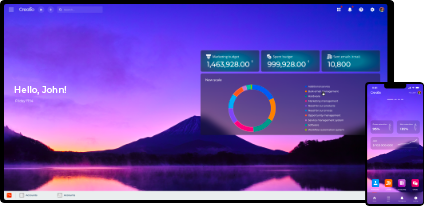Revenue Growth Management (RGM) Guide - Everything You Need to Know in 2025

Revenue growth management (RGM) is an integrated approach to maximizing profitability and driving sustainable business growth. By leveraging data-driven insights, RGM enables companies to optimize key elements of their revenue strategy, including pricing, promotions, product portfolios, and channel performance. With the potential to increase annual gross margins by 4 to 7 percent, as highlighted by McKinsey, RGM is a critical strategy for businesses aiming to grow revenue in competitive and rapidly changing markets.
This article explains the fundamentals of revenue growth management, exploring its main principles, benefits, and the role of AI-powered tools like Creatio in enabling businesses to execute these strategies effectively.
What is Revenue Growth Management?
Revenue growth management is a process of optimizing products, pricing, and promotions to drive business profitability across all industries. Based on data analysis of customer behavior, market conditions, and business performance, RGM strategies help businesses improve their product offerings, optimize pricing, diversify channels, and streamline sales processes. For example, revenue growth management can help businesses decide what products to sell, at what price, through which channels, and how to promote them to boost their revenue.
Revenue growth management requires cross-departmental collaboration across the whole organization, including marketing and sales teams, finance departments, supply chain stakeholders, and R&D teams. The goal of this collaboration is to develop a long-term, end-to-end growth strategy.

McKinsey - Revenue growth management: Building capabilities to sustain impact
Main Principles of Revenue Growth Management
Revenue growth management is built on several principles that help companies effectively maximize their revenue potential. These pillars ensure that businesses achieve sustainable growth and long-term success.
The main principles of RGM include:

- Product mix and portfolio management - selecting an assortment of products sold by the company in specific markets, based on product performance, market trends, and customer preferences. To maximize revenue growth businesses should prioritize high-margin products, introduce new offerings, and discontinue underperforming ones.
- Pricing optimization - developing pricing strategies based on customer demand, market conditions, and competitive benchmarking. Businesses should dynamically adjust their prices to market shifts, seasonality, and various customer segments.
- Promotional strategy - introducing promotional strategies that drive short-term sales such as limited-time offers, discounts, bundle offers, and loyalty programs. The key is to find the right promotional mix that will influence consumer behavior and encourage them to buy more products.
- Demand and sales forecasting - identifying emerging customer preferences and forecasting sales to accurately align inventory, and sales tactics with anticipated demand.
- Channel strategy - evaluating distribution channels to find the best platforms to reach the target audience. By creating the right mix of different channels, and working on maximizing their efficiency, businesses can increase their revenue and reduce costs associated with focusing on the wrong channels.
- Competitive analysis - evaluating the market to understand how competitors price, promote, and position their products. These insights help businesses optimize their strategies to gain a competitive edge.
- Revenue analytics - evaluating revenue performance against key metrics to identify areas of improvement, and make adjustments in real-time to fuel profitable revenue growth.
Benefits of Revenue Growth Management
Revenue growth management helps businesses optimize their profitability, increase competitive advantage, and ensure long-term sustainability.
Here’s a list of RMG benefits:
1. Increased profitability
Businesses that efficiently implement revenue growth management strategies can achieve profitable revenue growth. By dynamically adjusting their pricing, promotional efforts, and product offerings, companies across all industries can boost their profit margins.
2. Enhanced customer acquisition and retention
Thanks to analytics and data-driven insights, which are the backbone of RGM, businesses can eliminate guess-work and tailor their products and pricing to meet their customer needs. By offering the right products at the right price, companies can enhance customer acquisition efforts, and expand their customer base.
By offering personalized approaches, businesses can also improve customer engagement, strengthen relationships with clients, and ensure their long-term loyalty.
3. Reduced costs
RGM helps businesses reduce costs by identifying inefficiencies and focusing on what truly drives results. By analyzing performance data, companies can eliminate wasteful spending on products, channels, or marketing strategies that fail to deliver ROI.
For example, companies can stop wasting money on producing underperforming products and focus on more profitable ones, redirect resources from distribution channels that don’t generate satisfactory results, or adjust marketing campaigns to increase their effectiveness.
Thanks to the insights delivered in real-time by revenue growth management, businesses can quickly allocate resources to the most profitable opportunities, adapt to changing market conditions, and capitalize on new market trends. This agility helps organizations reduce unnecessary costs and maximize their revenue potential.
4. Competitive advantage
RGM enables businesses to anticipate market shifts, tailor offerings to emerging market trends, and optimize pricing strategies, helping them gain an advantage over their less agile competitors.
5. Efficient resource allocation
RGM ensures that resources, whether financial, human, or operational, are allocated to the areas that deliver the highest returns. This reduces waste and maximizes efficiency across the organization.
6. Improved decision-making
Revenue management supports business decision-making processes by delivering reliable, real-time data. Whether it’s optimizing prices, introducing new products and channels, or entering new markets, RGM provides actionable insights organizations need to achieve their business objectives.
7. Risk mitigation
RGM equips businesses with tools to forecast and adapt to market volatility, economic shifts, or competitive disruptions. This reduces the risks associated with pricing errors, inventory mismanagement, or poorly timed promotions.
Main Features of Revenue Growth Management Software
Businesses that want to implement revenue growth strategies can benefit from the help of a specialized revenue growth management platform, such as Creatio, which provides the tools to streamline and optimize RGM processes.
Key features of RGM software offered by Creatio include:
Pricing optimization
Creatio offers tools to help businesses optimize their strategic pricing for different products, customer segments, and distribution channels. With comprehensive sales, pricing, and profitability analytics, companies can effectively optimize their pricing to achieve higher profitability.
Sales performance analysis
Sales performance analytics tools provide rich dashboards and sales reporting capabilities to track sales KPIs in real-time as well as run historical analysis. Businesses can use this feature to analyze past and present performance and use insights to optimize the effectiveness of their sales strategy.
Sales forecasting
A revenue growth management platform provides powerful sales forecasting capabilities that allow businesses to predict sales trends and align inventory and production with anticipated demand. Using advanced analytics powered by AI technology to analyze market dynamics and consumer behavior, Creatio empowers organizations to accurately forecast future sales.
Customer 360
Creatio provides a complete view of contacts and accounts with all customer data, insights, transaction history, and engagement scoring. These insights help businesses better understand their customers and tailor their offerings to meet their needs and preferences.
Product planning
This feature helps businesses generate data-driven product plans across all channels, regions, and stores, as well as make predictions about crucial future market positions with the use of robust analytics and AI tools.
Campaign management
Campaign management feature offers advanced capabilities to budget, execute, and track marketing campaigns and projects of any complexity. Creatio facilitates campaign management with a rich visual designer and intuitive analytics that help businesses increase the effectiveness of their marketing efforts.
Workflow automation
Creatio offers automation capabilities to streamline workflows, such as pricing updates, and marketing campaign execution to increase efficiency and productivity across the organization.
Advanced analytics and reporting
Advanced analytics and reporting capabilities allow businesses to gain insights into pricing, customer behavior, and market trends through real-time data analysis and customizable dashboards.
Seamless integration with existing systems
Creatio seamlessly connects with the whole business ecosystem to ensure a unified view of operations and revenue performance.
AI in Revenue Growth Management
Artificial Intelligence empowers revenue growth management with advanced tools to analyze data, predict trends, and automate complex workflows. Creatio offers an AI-native platform that combines predictive, agentic, and generative AI to help businesses refine their strategies to increase profit, optimize operations, and achieve sustainable revenue growth.
Here’s how Creatio AI can support RGM operations through its key capabilities:
Predictive AI - forecasting trends and sales
Creatio AI quickly analyzes vast amounts of historical and real-time data to accurately anticipate future trends, customer behaviors, and market shifts. This capability allows businesses to make informed decisions about their sales strategy and quickly pivot to more profitable products, pricing strategies, and promotional efforts.
Predictive analytics can forecast future demand and emerging trends, enabling businesses to improve their inventory management and adjust product portfolio. It can also identify high-value customers, predict their future needs, and help companies personalize their offers and promotions to increase customer satisfaction and sales.
By leveraging the powerful capabilities of predictive AI, businesses can reduce guesswork and make decisions that will help them achieve long-term revenue growth goals.
Agentic AI - automating revenue-driving processes
Agentic AI focuses on automating repetitive tasks and making autonomous decisions about executing and improving complex RGM processes. Creatio AI automates complex workflows without human intervention, streamlining revenue growth management and improving employee productivity.
Creatio AI can dynamically adjust product prices based on demand, competition, and market conditions to increase revenue. Thanks to AI automation, employees don’t have to comb through data and manually change prices, which helps eliminate hours of manual work. Agentic AI can also monitor and optimize the performance of distribution channels in real time, redirecting resources to the most profitable ones.
Businesses can also use AI-empowered automation to enhance their marketing efforts and ensure resources are directed at the most effective campaigns and channels, based on analysis of past campaign performance.
Generative AI - generating tailored content
Generative AI enhances RGM by producing creative content, personalized offers, and innovative solutions that resonate with customers, driving revenue growth.
Creatio AI enables businesses to personalize marketing efforts by creating tailored email campaigns, product recommendations, and promotion materials based on analysis of customer preferences and needs.
Generative AI can also help organizations design new products and promotional strategies by analyzing market gaps and competitors’ offerings. With GenAI capabilities provided by Creatio, businesses can speed up the designing, and iteration of new products and quickly answer emerging demands and trends.
Creatio AI can also assist businesses with generating performance reports, and analyzing vast amounts of data to provide real-time insights into key revenue metrics, including pricing effectiveness, sales trends, and channel profitability. By automating the creation of detailed reports, Creatio AI saves employees time, reduces human error, and ensures decision-makers have the information they need to fine-tune strategies and drive profitable growth.






